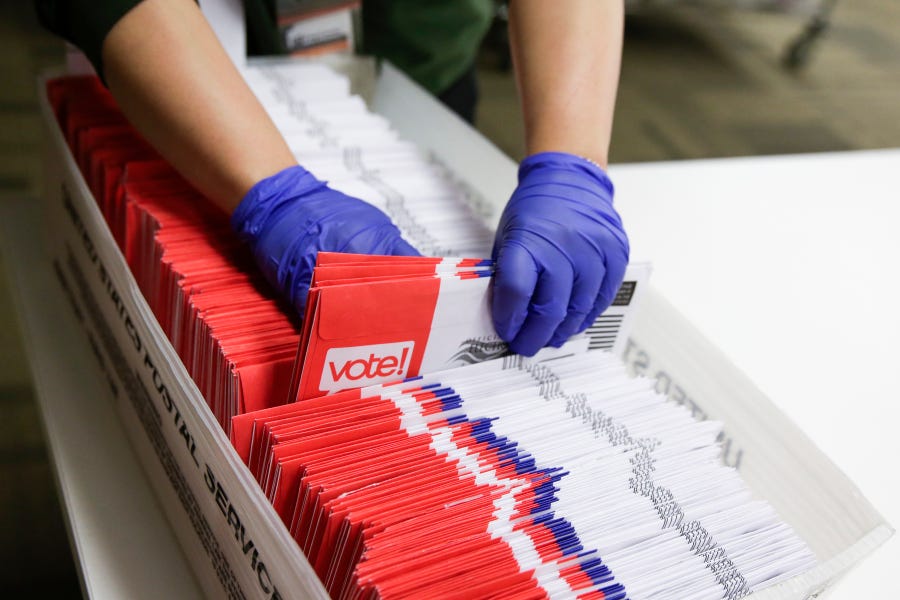During a press briefing on Thursday, White House press secretary Kayleigh McEnany claimed that “somehow in L.A. County 112 percent of Los Angeles County is registered to vote.” The Washington Post disputed this claim, titling a video of the remark, “McEnany falsely says voter registration rate in Los Angeles County is 112 percent.”
McEnany also made the claim at several points throughout the week, first in a viral tweet and then during a Fox News interview Thursday, in which she stated: “In L.A. County you have 112 percent of the population registered—ask yourself how that happens—and 112 percent of the population gets a ballot. Well that leaves 12 percent subject to fraud—at least 12 percent.”
The basis for McEnany’s claims is a 2017 lawsuit brought by activism group Judicial Watch, which stated that Los Angeles County and 10 other counties in California had more registered voters than eligible adults. Contrary to what the Washington Post headline stated, Los Angeles County did have more registered voters than eligible adults. However, McEnany’s presentation of this fact isn’t completely accurate either: Rather than evidence of mass voter fraud, the 112 percent statistic is due to counting both active and inactive registered voters.
Registered voters may be deemed inactive if a county is informed of a change of address by the Postal Service or certain types of mailed official documents (found on page 88 of this California election manual)—like a residency confirmation postcard, which counties are required to send out 90 days before an election—are returned as undeliverable.
Inactive voters are allowed to cast provisional ballots in elections in California, but the California Elections Code prevents inactive voters from being mailed any election materials—see Section 2226 a(2). But Gov. Gavin Newsom’s executive order establishing widespread vote-by-mail for the November 3, 2020, election set aside the limitations placed on vote-by-mail elections in the California Elections Code and state law to ensure that “every Californian who is eligible to vote in the November 3, 2020 General Election shall receive a vote-by-mail ballot.” The order also states that Newsom’s administration will work with the secretary of state and legislature to determine further details about the implementation of the order. According to representatives for California Secretary of State Alex Padilla, one detail has already been settled: The administration will maintain the Election Codes’ exclusion of inactive voters from vote-by-mail. One Padilla representative told PolitiFact: “Only active registered voters will be mailed a ballot ahead of the November 3, 2020 General Election.” Padilla’s press secretary echoed the claim to FactCheck.Org, saying, “Vote-by-mail ballots will only be sent to active registered voters ahead of the November 3, 2020 General Election.”
However, despite the secretary of state’s assurances, there is nothing in the text of the executive order itself that says only active voters can participate in vote-by-mail, which led Republicans to sue Newsom over concerns ballots would be sent to inactive voters.
The county and Judicial Watch settled their lawsuit last year, and Los Angeles County officials agreed to purge inactive voters from election rolls, increasing efforts to remove deceased registered voters and creating a system in which inactive voters who fail to vote in two consecutive federal elections are deregistered. It’s unclear how many, if any, inactive voters have been removed since this agreement was struck in January 2019—the most recent data from the U.S. Election Assistance Commission showed 5,280,658 active registered voters and 1,577,801 inactive registered voters, a slight increase from the 1,515,330 inactive registered voters Judicial Watch mentioned in its lawsuit. The most recent information, however, was recorded in 2018, before the county government agreed to clean up its voter log. Neither the California secretary of state’s office nor the L.A. County registrar’s office responded to requests for comment.
Based on available information, both McEnany and the Washington Post’s claims have some merit: Unless inactive voter removal has already occurred, Los Angeles County’s total voter registration likely exceeds its eligible voter population. However, given that the situation is due to the inclusion of inactive voters, McEnany is incorrect to suggest the high number is attributable to fraud.
If you have a claim you would like to see us fact check, please send us an email at factcheck@thedispatch.com. If you would like to suggest a correction to this piece or any other Dispatch article, please email corrections@thedispatch.com.







Please note that we at The Dispatch hold ourselves, our work, and our commenters to a higher standard than other places on the internet. We welcome comments that foster genuine debate or discussion—including comments critical of us or our work—but responses that include ad hominem attacks on fellow Dispatch members or are intended to stoke fear and anger may be moderated.
With your membership, you only have the ability to comment on The Morning Dispatch articles. Consider upgrading to join the conversation everywhere.